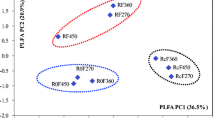Abstract
In an abandoned corn field, clear-cutting of crop vegetation increased the productivity, species richness, and nonannuals in the following years after abandonment, as compared to the control plots from which crop vegetation was not removed. The increase in plant growth was apparently due to the elimination of allelopathic chemicals from the soil, which normally are released from the standing crop. Removal of vegetation also increased the soil mineralization of Ca2+, Mg2+, K+, NH4 + and NO3 −-N. This situation encouraged species having higher mineral requirements to rapidly invade the fields in the successive years. Clear-cutting also increased the nitrification process by removing the inhibitors of nitrification. The number ofNitrosomonas was always significantly higher in the harvested plots as compared to unharvested plots. Phenolic phytotoxins were isolated from the crop residue and soil. Further, these phytotoxins were significantly higher in the unharvested crops as compared to clear-cut plots, in most samples. Whatever the direct or indirect additional explanation for increased biomass, nonannuals and richness in successive years, it is clear that the removal of standing crop has a definite influence.
Similar content being viewed by others
References
Boughey, A.S., Munro, P.E., Meiklejohn, J., Strang, R.M., andSwift, M.J. 1964. Antibiotic reactions between African savanna species.Nature 203:1302–1303.
Chou, C.H., andPatrick, Z.A. 1976. Identification and phytotoxic activity of compounds produced during decomposition of corn and rye residues in soil.J. Chem. Ecol. 2:369–387.
Danks, M.L., Fletcher, J.S., andRice, E.L. 1975. Influence of ferulic acid on mineral depletion and uptake of 86 Rb Paul's scarlet rose cell-suspension.Am. J. Bot. 62:749–755.
Demos, I.K., Woodwine, M., Wilson, R.H., andMcMillan, C. 1975. The effects of ten phenolic compounds on hypocotyl growth and mitochondrial metabolism of mung bean.Am. J. Bot. 62:97–102.
Drew, W.B. 1942. The revegetation of abandoned cropland in the Cedar Creek area, Boone and Callaway counties, Missouri.Mo. Agr. Exp. Sta., Bull., 344.
Einhellig, F.A., Rice, E.L., Risser, P.G., andWender, S.H. 1970. Effects of scopoletin on growth, CO2 exchange rates, and concentration of scopoletin, scopolin, and chlorogenic acids in tobacco, sunflower, and pigweed.Bull. Torrey Bot. Club 97:22–33.
Gortner, W.A., andKent, M.J. 1958. The coenzyme requirement and enzyme inhibitions of pineapple IAA oxidase.J. Biol. Chem. 233:731–735.
Guenzi, W.D., andMcCalla, T.M. 1962. Inhibition of germination and seedling development by crop residues.Soil Sci. Soc. Am., Proc. 26:456–458.
Lodhi, M.A.K. 1975a. Allelopathic effects of hackberry in a bottomland forest community.J. Chem. Ecol. 2:171–182.
Lodhi, M.A.K. 1975b. Soil-plant phytotoxicity and its possible significance in patterning of herbaceous vegetation in a bottomland forest.Am. J. Bot. 62:618–622.
Lodhi, M.A.K. 1977. The influence and comparison of individual forest trees on soil properties and possible inhibition of nitrification due to intact vegetation.Am. J. Bot. 64:260–264.
Lodhi, M.A.K. 1978a. Allelopathic effects of decaying litter of dominant trees and their associated soil in a lowland forest community.Am. J. Bot. 65:340–344.
Lodhi, M.A.K. 1978b. Comparative inhibition of nitrifiers and nitrification in a forest community as a result of the allelopathic nature of various tree species.Am. J. Bot. 65:1135–1137.
Lodhi, M.A.K. 1979. Inhibition of nitrifying bacteria, nitrification and mineralization in spoil soil as related to their successional stages.Bull. Torrey Bot. Club 106:284–289.
Lodhi, M.A.K., andNickell, G.L. 1973. Effects of leaf extracts ofCeltis laevigata on growth, water content, and carbon dioxide exchange rates of three grass species.Bull. Torrey Bot. Club 100:159–165.
Machackova, I., andZmrhal, Z. 1976. Comparison of the effect of some phenolic compounds on wheat coleoptile section growth with their effect on IAA-oxidase activity.Biol. Plant. 18:147–151.
Patrick, Z.A. 1971. Phytotoxic substances associated with the decomposition in soil of plant residues.Soil Sci. 3:13–18.
Rasmussen, J.A., andEinhellig, F.A. 1977. Synergistic inhibitory effects ofp-coumaric and ferulic acids on germination and growth of grain sorghum.J. Chem. Ecol. 3:197–205.
Rice, E.L., andPancholy, S.K. 1974. Inhibition of nitrification by climax ecosystems. III. Inhibitors other than tannins.Am. J. Bot. 61:1095–1103.
Rice, E.L., andParenti, R.L. 1978. Causes of decreases in productivity in undisturbed tall grass prairie.Am. J. Bot. 65:1091–1097.
Rice, E.L., Penfound, W.T., andRohrrbaugh, L.M. 1960. Seed dispersal and mineral nutrition in succession in abandoned fields in central Oklahoma.Ecology 41:224–228.
Author information
Authors and Affiliations
Rights and permissions
About this article
Cite this article
Lodhi, M.A.K. Accelerated soil mineralization, nitrification, and revegetation of abandoned fields due to the removal of crop-soil phytotoxicity. J Chem Ecol 7, 685–694 (1981). https://doi.org/10.1007/BF00990301
Received:
Revised:
Issue Date:
DOI: https://doi.org/10.1007/BF00990301




